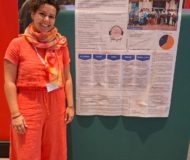

A study by the Parkinson’s Disease and Movement Disorders Research Group at the Sant Pau Research Institute (IR Sant Pau), led by Dr. Jaume Kulisevsky, concludes that music therapy is an effective tool in the psychosocial treatment and speech rehabilitation for people with Parkinson’s disease. The results were presented in Leicester by researcher and music therapist Judit Soler Almendros during the BAMT 2024 Congress (British Association for Music Therapy).
The research focused on the ParkinSongs choir and evaluated the significance it holds for participants, as well as the benefits of music therapy at the vocal, cognitive, emotional, and social levels. This evaluation was carried out with the aim of better understanding the effectiveness of music therapy as a psychosocial treatment and speech rehabilitation for people with this neurodegenerative disease.
The evaluation consisted of a questionnaire and small discussion groups involving most members of the ParkinSongs choir. The information obtained was processed through a reflexive thematic analysis, identifying five main themes: sense of belonging, music, voice, disease progression, and mood.
Key results highlight that participants indicate music helps them disconnect from daily worries and serves as a point of connection between members. From the perspective of the disease, participation in the choir is considered an essential tool for reducing the progression of speech difficulties and helps them better cope with everyday symptoms. Additionally, participants report that choir rehearsal days are better, with fewer “off” periods, and they always feel better after singing.
Dr. Carmen Garcia-Sánchez, a researcher at IR and neuropsychologist at the Neurology Service of Sant Pau Hospital, indicates that these results suggest that music therapy can be an effective tool in the psychosocial treatment and speech rehabilitation in Parkinson’s disease. The findings provide evidence of the usefulness of integrating music therapy into the treatment of these patients, highlighting its benefits not only in reducing physical and physiological symptoms but also in improving their emotional and social well-being.